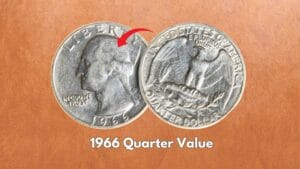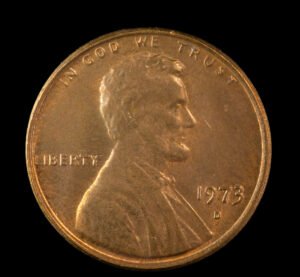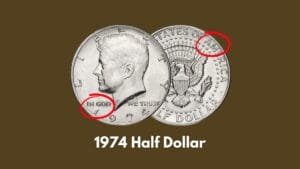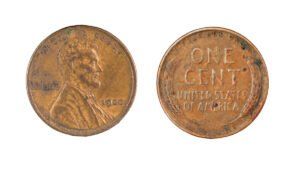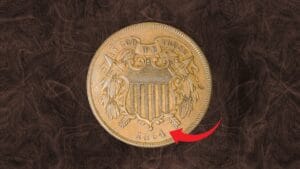Do you know why people still collect the 1967 copper-clad Washington quarters today? What makes these coins valuable, despite their basic silver-less composition and high mintage?
In Jan 2017, the PCGS quoted that a standard, uncirculated 1967 quarter was sold for $8,812 at Heritage auctions.
And such high values are not new to the 1967 Washington Quarters. Collectors love them for their special mint sets, colors and an illustrated obverse that pays a tribute to George Washington, the first US President. But is this all, or are there any more valuable features?
Let’s have a look!
Key Takeaways
- Despite their easy availability and high mintage, people love the 1967 Washington Quarters for their original cupronickel cladding and colors.
- Unique minting errors like a double-die, off-center, or clipped planchet error can raise your quarter’s value up to $100 today.
- Old 1967 Washington Quarters come in three colors, of which the brown ones are rare and expensive, costing up to $550.
- The 1967 Washington Quarters don’t have any mint marks due to the Coinage Act of 1965.
The Interesting History of the 1967 Quarters
Introduced in 1932 to honor the 200th birth Anniversary of George Washington, the first US President, the Washington Quarter went through several historical and composition changes as follows:

- 1932: The Congress introduced the Washington Quarter based on a bust cameo submitted by the official designer and engraver John Flanagan. Surprisingly, this coin had about 90% or 5.623 grams of pure silver, while the rest was copper!
- 1964: Silver costs reached an all-time high of $1.30/oz, leading to the hoarding and remelting of these coins for silver.
- 1965: On June 3, 1965, the 36th President of the US, Lyndon Johnson, introduced the ‘Sandwich Law (Coinage Act of 1965),’ which urged the official mints to eliminate silver and focus on nickel and copper instead. So, a mixed alloy of 91.67% copper core & 8.33% nickel was finalized.
- 1966: The Congress passed an act to cease the use of mint marks, even on the Denver and San Francisco coins.
- 1967: Over 1 billion Washington Quarters, each with the President’s cameo on the obverse and a heraldic eagle on the reverse, were minted in Philadelphia and are circulated to date, with some minor reverse design revisions in 1975.
| 1967 Washington Quarter | Key Features |
| Material Composition | 91.67% Copper and 8.33% Nickel for the cladding |
| Minting Location | Philadelphia & San Francisco |
| Year of Minting | 1967 |
| Coin Weight | 5.67 grams |
| Diameter | 24.3mm |
| Thickness | 1.75mm |
| Designer & Engraver | John Flanagan |
| Face Value | 25 cents or $0.25 |
| Mint Mark | No mint marks (due to Coinage Act) |
| Total Mintage | 1,524,031,848 |
How to Identify 1967 Quarters Based on Their Design?
The 1967 Quarters, designed by the famous U.S. Mint Engraver John Flanagan, have the same design features as the earliest 1932 quarters. So let’s check the details here:
1. Obverse (Heads) Design:

You can identify a 1967 quarter’s obverse design by the following features:
- A large, left-facing portrait of George Washington, the first US President
- The phrase ‘IN GOD WE TRUST’ inscribed under the President’s chin, on the left
- The word ‘LIBERTY’ carved along the upper rim, above the President’s profile
- The mint year ‘1967’ engraved under the cameo
2. Reverse (Tails) Design:

Designed by John Flanagan, the 1967 Quarter’s design highlights the following features:
- A huge left-faced heraldic eagle with sprawling wings in the center
- A group of arrows and a curved olive branch (a symbol of war and peace) in the eagle’s claws
- The Latin phrase ‘E PLURIBUS UNUM’ engraved above the eagle’s head, between its leaning wings in the center
- The nation’s name ‘UNITED STATES OF AMERICA’ inscribed along half of the upper rim
- The face value ‘Quarter Dollar’ is written at the bottom, under the olive branch
3. Coin Composition & Dimensions
All the 1,524,031,848 quarters minted in Philadelphia have a sturdy, 75% copper core and a shiny, cupronickel-clad layer. However, since these cupronickel layers constitute about 1/3rd of the coin’s weight, the total copper content changes to 91.67% copper and 8.33% nickel.
Besides, the coin has a decent diameter of 24.3mm, with a 1.75mm thickness and a reeded edge comprising 119 uniform reeds.
4 Valuation Factors of a 1967 Washington Quarter
1. Coin’s Condition & Grading
Despite a high mintage of over 1.5 billion coins, some of the 1967 Washington quarters fetch up to $6,000 due to their grade and mint-state condition. That means these coins don’t have any visible stains, discoloration, or black tarnish on their surfaces. Also, the motifs are very sharp and free of cracks and chips.
Want to know if you have such a rare coin? Well, ask a professional grading service like NGC or PCGS to grade your coin, and then check its value below:
| Coin’s Condition or Grade | Estimated Value |
| Good to Very Fine (VF+) | Less than 30 cents |
| Extremely Fine (XF 40) – Almost Uncirculated (AU58) | Less than $1 (error coins can cost up to $150) |
| MS60 – MS65 | $2 – 40 |
| MS66 – MS67 | $20 – 850 |
| MS68 & Above | $2,000 – 8,800 |
2. 1967 Washington Quarter Colors
You’ll get old, 1967 Quarters in three copper tones – gray, brown, and reddish brown. And after researching e-commerce sites like eBay & Etsy, I found that the brown ones cost up to $500 in a high mint state. The other coins aren’t that valuable, unless with higher grades or errors.
Here’s how the cost changes as per the different 1967 Washington Quarter colors:
| 1967 Washington Quarter Colors | Average Value |
| Brown (BN) | 90 cents – $550, as per the grade |
| Reddish Brown (RB) | 30 cents – $50 |
| Gray | 90 cents – $500 |
3. Special Mint Sets (SMS)

Apart from the 1 billion Washington Quarters minted in Philadelphia, the San Francisco mint produced 1,863,344 proof coins, also known as the Special Mint Sets for collectors, with the following features:
And here’s what a special mint set Washington Quarter looks like:
- Unique business strike coins with a reflective, lustrous finish
- Crisp, frosted details and design elements
- Struck on specially prepared, polished dies and planchets
- Come with fully enclosed metal case
- Strong contrast between background and relief elements
But that’s not all! These SMS coins are also available as Cameo sets, featuring high contrast between the reliefs and foreground. So let’s check the resale values of those:
| SMS Coin’s Grade & Condition | 1967 25C SMS Coin | 1967 25C SMS, DCAM Coin (Cameo) |
| Mint State (MS 66 – 69) | $10 – 250 | $150 – 4,300 |
| Highest Auction Record | $610 | $4,465 |
1967 Washington Quarters with a doubly struck reverse error cost $100 – 250 in mint state.
4. 1967 Washington Quarter Errors
Do you know that some of the most premium 1967 Washington Quarters are full of minting errors? For instance, they might have visible doubling, cladding, or a few more minting errors as follows:
1. Double Die Error: The double die error occurs when an extra image from a previous stamping is transferred to the next coin. So, such coins have double or bold strokes, especially around the mint years and mottos. Overall, they cost about $20 – 100.

2. Rim Error Quarter: As the name says, this error leads to a raised, damaged rim. So, you might see some folded or edges and disoriented letters at the borders. But, this error doesn’t add value, costing 30 – 50 cents, even for mint-state coins.
3. Off-Center Error: This is another common error in which the President’s cameo on the obverse is struck to the right, leaving a plain void on the left. But, a 1967 Washington Quarter with this error can cost $5 – 100.
4. Clipped Planchet Error: This was a prominent error in the earliest 1967 coins, caused by a sharp strike, which caused the planchet to chip off. You can identify such coins by their broken planchets and sharp details, especially around the President’s hair.
5. Quarter Struck on 10c Dime Planchet: If your coin has a smaller diameter, up to 17.91mm, it might be struck on a 10-cent planchet. Also, most of the design, especially the mint date and motto, will be missing due to the size difference!
How Do You Spot a Fake 1967 Washington Quarter?
Well, we know that the market is full of counterfeits and scammers, each trying to sell a FAKE coin for a higher value. But worry not! You can identify such bogus coins easily by spotting the FAKE features below:
- Different design details, especially along the President’s hair
- Changed font or stroke width
- Magnetic nature
- No aging features and a reflective, polished surface
- Different coin dimensions and weight
- Presence of minting marks
- Might have plain or smooth edges
Is a 1967 Washington Quarter Real Silver?
No, a 1967 Washington Quarter doesn’t use silver and has a simple structure of 91.67% copper and 8.33% nickel under the ‘Coinage Act of 1965.’
How Rare is a 1967 Quarter With No Mint Mark?
1967 no-mint Quarters have a high mintage of 1.5 billion coins! So, these coins are pretty common unless they have some unusual rim or die errors.
Despite a high mintage, the 1967 Washington Quarter is a popular coin for its Presidential obverse and typical US war and peace motifs on the reverse. So, if you already have such a quarter, use my guide to check its grade, color and estimate the right resale value accordingly!
But if you are looking for more Presidential tribute coins, join in to learn more about the ‘1964 Jefferson Nickel’ and ‘1982 Lincoln Penny.’
Note: This article is intended for informational, educational, and entertainment purposes only. Some images are illustrative and may not represent actual brands, products, or related entities. All trademarks, product names, brand logos, packaging, and other intellectual property referenced remain the exclusive property of their respective owners. Any brand mentions or references are provided solely for descriptive and educational context and do not imply any formal or commercial association.



